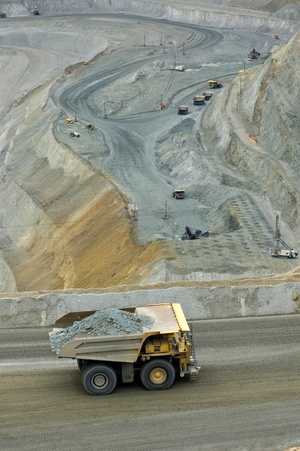What impact do emissions targets from organisations such as the International Energy Agency (IEA) have on the mining industry?
This targets give the mining industry a vision of what they should be aiming towards. Now, the mining industry has been a little bit slow to adopt targets that are aggressive enough for meeting what the IEA and other organisations such as GRI or CDP recommend, but we are seeing a little more traction in the industry.
There was a large BHP announcement recently; the company is taking steps to not only go net zero emissions by 2050, but it has committed to reducing its Scope 3 emissions as well [The Greenhouse Gas Protocol Corporate Standard defines Scope 3 emissions as all indirect emissions, excluding indirect emissions from the generation of purchased energy, that occur in the value chain of the reporting company, including both upstream and downstream]. I believe it is the first time a mining company has taken that stand, and that's really encouraging to see.
All that said, there are still a lot of companies that either don't have emissions targets at this point, or have set targets that are relatively soft and don't fit the vision that IEA and others have. One challenge is that there is no direct enforcement mechanism from any of these organisations.
Why are diesel-powered haul trucks an ideal place to improve the sustainability of mining operations?
Diesel trucks are a great place to start for several reasons. The first is that there are a lot of them - globally, the estimates show there are around 28,000 of these diesel haul trucks at mines and they use quite a bit of diesel fuel.

Thomas Kirk, manager at the Rocky Mountain Institute
The average use that we find is around 900,000L per truck per year, and this means that they make up a pretty significant proportion of a mine's operating costs and overall energy use - typically anywhere between 30-50% of the total mine's energy use is the diesel for these trucks.
That much diesel contributes a fair amount of carbon emissions, and other pollutants as well such as particulate matter and carbon dioxide that can impact the health of the workers on site. This gives us a large target for reducing carbon across mine sites as well as improving worker health, and there are a lot of different options for improving the sustainability of trucks.
You can look at alternative fuels; you can use non-trucking solutions like in-pit crushing and conveying; or you can use what we call advanced trucking technology that's still being developed with electric vehicles or fuel cells.
The real benefit is that anytime you put in hydrogen or electrification you're enabling more renewable energy to be used on site. So you can take these trucks and turn them from something that is historically fairly rough in terms of its carbon emissions and pollution, and change it to something where it's enabling more renewable energy use on site.
What are the best alternatives to haulage using diesel-powered trucks?
Of course, this is going to depend dramatically on the mine's situation - are you trying to retrofit a mine, is it a greenfield design you're looking at, is it open pit or underground?
But the broad answer, knowing that there are caveats to it, is that if you have a greenfield site with proper topography and characteristics that allow for in-pit crushing and conveying, that is generally hands-down the best solution. It is more energy efficient, lowers operational cost, and as long as your mine can both allow for it physically and has a long enough life of mine, it will provide the best economic return on beating out fuel trucks.
If you're looking at an underground mine, and again have enough life of mine left, electric vehicles are really making strides in this area. They also provide even more benefits, especially around the health and safety aspect of not having to worry about combustion in an enclosed area.
Now, the tough nut to crack here is an operational open-pit mine. The hard truth is that there isn't a great overall solution at this point. If the mine can't do in-pit crushing and conveying, the next step I would recommend would be looking at trolley assist. With this, you're relying on electricity which can become greener over time, depending on how it's supplied.
There are also a lot of stop-gap measures around either alternative fuels or fuel blending. They can be a lot easier to implement since you don't change out your existing fleet at all, you can keep most of the operations the same, and put in for example 20% biodiesel. The challenge here is that you're not going to get a lot of gain out of doing that. You'll get some reduction of pollutants, you'll get some reduction of carbon, but if you are trying to meet those IEA targets it's simply not going to buy you that much time in terms of what your carbon footprint would need to be by 2050.
What initial steps would you suggest to a mining company that wants to improve the sustainability of its hauling?

Typically anywhere between 30-50% of a mine's total energy use is the diesel for haul trucks
If you're looking just at hauling, the first thing would be to determine what the sites are that you can overdeliver on. For example, if you have a greenfield site being developed or planned now, how can you make it work with in-pit crushing and conveying, what are the technologies you can bring in to design the whole site with it, you know, create a renewable penetration goal in mind of lower emissions. And then, try to overdeliver on those sites where these things work.
If you have an underground mine, try to go as much electric as you can, and almost holding off on those active open-pit sites, so you can get deeper decarbonisation efforts in place.
Then, the second step is to see how you can expand this, knowing that the technology of electric haulers or hydrogen fuel cell haulers is still being developed at this point - can you look at other areas of the mine? Are there other things or processes on site that can be electrified or use renewable thermal heat, to get the decarbonisation efforts there?
And then the final point is to see how you can accelerate technology readiness.
What role could mining companies play in researching and developing technologies that enable more sustainable hauling?
I think mining companies have a big role to play in this. The first thing is by investing in the research and policy support needed to provide the incentive to start moving these technologies forward. They can act as pilot testers for technology companies.
Mining companies should be asking those companies and equipment vendors to provide the services to them. They could say, we don't see a large-scale hydrogen haul truck in the market yet, how can we work with you and partner with you to make this a reality? I think vendors have an incentive to sell more trucks to people, and if those are the trucks people want to buy they'll start making them.
There's also what I'm going to call external pushes as well, so the mining companies not just partnering with vendors, but trying to be as transparent with the market as possible about what progress they're making towards decarbonising. Eventually, this could help create the markets for this low-carbon or green commodities.
An example we could use would be green steel. If a mining company can say that the iron ore that's going into the steel is certified low carbon, and you can track the emissions that are embedded in that steel at the output, I'm willing to bet that there are companies who would pay to buy low carbon or no carbon steel.
These incentives can be in the marketplace, but then I think mining companies also need to set sustainability performance incentives internally - this would allow for employees within the company who are taking action to be rewarded for that action. I think there's a great correlation, the things you're incentivising tend to happen.
The overarching thing is that mining companies should be investing this research so companies start having incentives to go and provide these products to the industry. Then if there's a market for these products out there, whether with a premium or without it, I think it'll happen more quickly. Then if the companies can incentivise action internally, more folks will take the initial steps to put these things in place.
Thomas Kirk will be giving a presentation at Future of Mining Americas 2019 on October 22 on ‘Hauling ourselves into the future: Improvements to the sustainability of hauling'.
Find out more options for decarbonising mine hauling in RMI's recent report: Pulling The Weight of Heavy Truck Decarbonization.
























